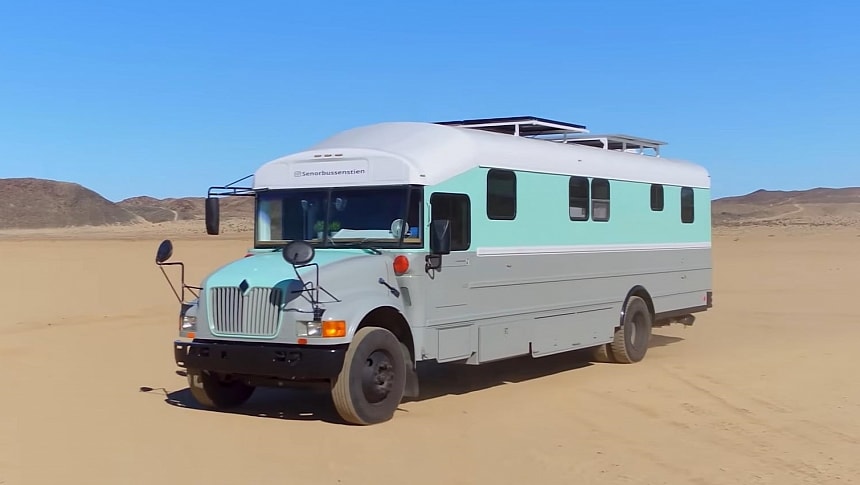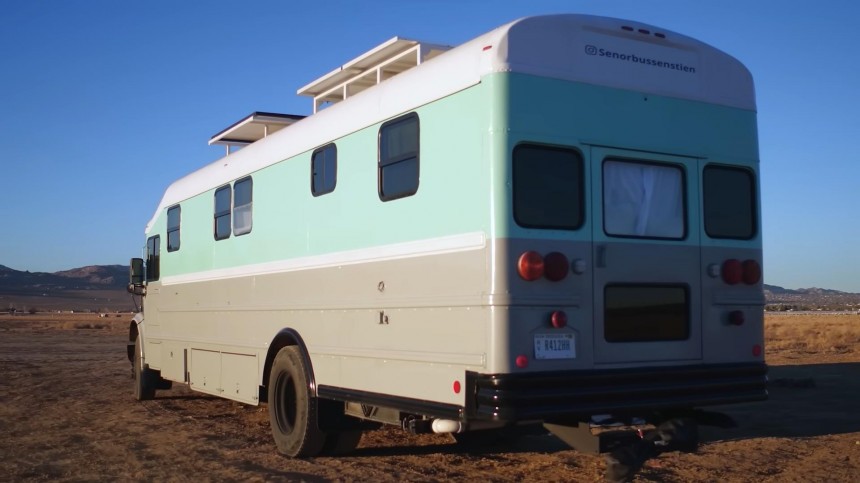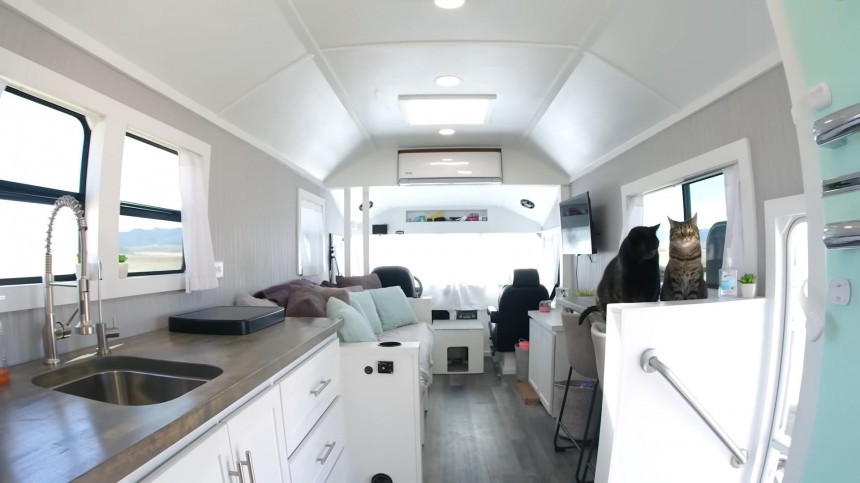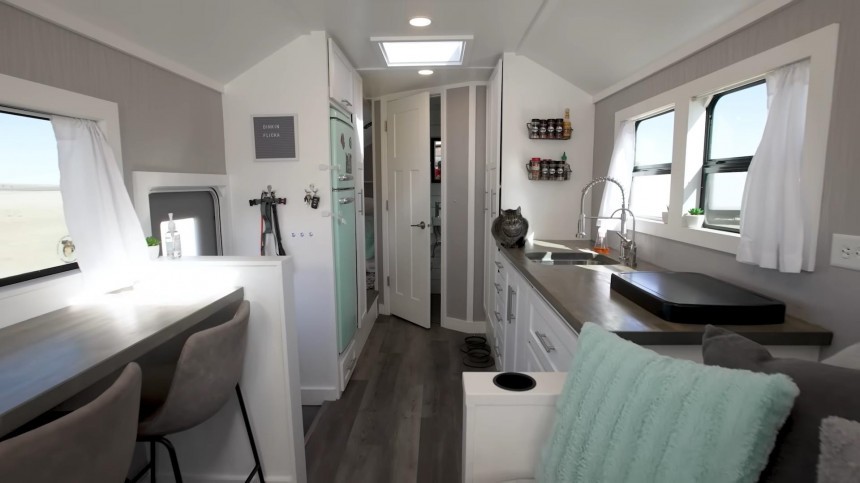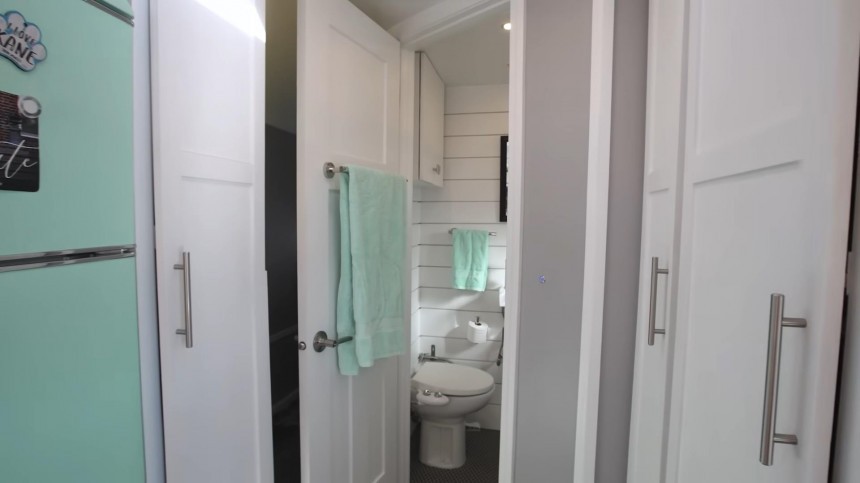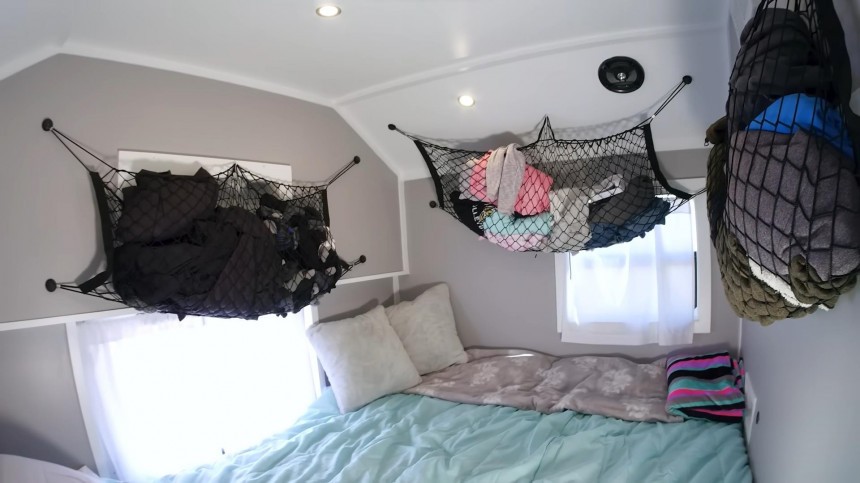People who start a mobile lifestyle come from all walks of life. However, there's one thing that all of them have in common: the need for adventure. Today, I'm checking out a couple who converted an old school bus into a stunning camper, which serves as a full-time tiny home on wheels that takes them all over the United States.
Some people, like Chris and Brandy, are the happiest when traveling and experiencing new things, be it new places, meeting new people, or any other novelty. So, the duo decided to leave the rat race most of us are familiar with to pursue a new lifestyle. But instead of converting a camper or buying an RV, they decided on a much more tedious yet fulfilling journey: converting a school bus into a home.
There are multiple advantages to converting a school bus; I listed most of them in this article. My assumption is that, for most people interested in creating a mobile home (so not buying one), it boils down to two things: how complex and how affordable the process is.
Regarding difficulty, which in this case I'm referring to manual labor and time and energy invested, converting a school bus is a challenging feat compared to other types of conversion. It has more real estate, so there are more spots to cover.
However, when it comes to affordability, you might discover that you're better off building a skoolie rather than a camper van or other types of vehicles. Most of the skoolies I've written about were made for around $30,000 to $40,000 (€27,628 to €36,837), although prices can significantly vary. For instance, this rig cost a mere $12K to make.
Anyway, let's get back to the couple. Let me cover the two points I just mentioned: it took Chris and Brandy 600 hours to build the interior. Moreover, the mobile home cost them a total of $45,000 (€41,442), including the base vehicle. Let's break the budget down: the duo spent a mere $3,000 (€2,763) for the base vehicle, $12,000 (€11,051) for the mechanical repairs, and $30,000 (€27,628) for the interior remodeling.
To be more specific, what we have here is an International AMtran bus with a DT455E engine paired with an Allison transmission. It tips the scales at 21,400 lb. (9,707 kg) in its current form. Moreover, Chris and Brandy also tow a 2019 Ram 1500 pick-up truck. Why? It makes short trips and general exploring much easier, and it also serves as an additional storage spot.
Due to the additional weight and because they tow a vehicle, this bus gets about 6.5 to 9 MPG (26 to 36 L/100km), depending on the road conditions. What's more, the rig has a 60-gallon (227-liter) fuel tank housed underneath, on the side.
Also, this is off-topic, but I love the creativity of people when naming their mobile homes: this couple's bus is named "Senor Bussenstein." If you're a fan of The Office series, you might recognize the name was inspired from one of its episodes.
This rig's exterior makes it very hard to miss on the road – it's finished in baby blue paint blended with a white roof on the top half and grey paint on the lower half. By the way, all the paint used on the exterior was Rustoleum.
Senor Bussenstein has a total of nine RV windows and two skylights, helping keep the interior as well-lit as possible. Furthermore, it has four under-mounted storage compartments.
At the rear, the couple kept the original emergency door, which leads into the garage in the lower part and into the bedroom in the upper part. The exterior tour ends with the roof, where you'll discover four solar panels with a total capacity of 1,200 W.
Now, let's check out the interior, which offers 210 square feet (19.5 square meters) of space. It looks like one you would find in a conventional home. There's a reason for that – Chris has done interior remodeling as a career, a very relevant skill to have when converting a school bus.
One of the most significant transformations of this bus was a roof raise. The couple did a 15-inch (38-centimeter) roof raise to have extra headspace and make it feel more like a home.
If you're familiar with campers, be they skoolies or vans, you know that most people choose to install overhead cabinets or shelves to have more space. Well, Chris and Brandy chose not to install them to make the interior feel roomier. Regarding the design, the couple opted for a white and grey blend: white for the ceiling and grey for the walls.
Starting with the driver's cabin, you'll notice that the couple added a passenger's chair and a box for their two cats. Another space dedicated to the acts is behind the driver's seat: there's a litter box hidden under a counter.
The next part of the interior is the lounge area – it features a 7-foot (2.1 meters) long couch with a futon mattress on the driver's side and a small counter with a wall-mounted TV above on the other side next to a large flip-up table with two chairs. Moreover, this area can be turned into an extra sleeping space for guests by extending the couch.
Walk deeper inside the bus, and you'll be in the kitchen, which is split into two parts. Surprisingly, the kitchen isn't as well-equipped as most kitchens you'll find in skoolies. It features a deep sink with a water filter, a two-burner stove, a beautiful residential refrigerator, two wall-mounted spice racks, and a butcher block countertop. For storage, there are many cabinets and drawers, as well as a massive pantry.
After the kitchen, things get interesting. What I mean is that you won't find straight hallways like in most skoolie builds; instead, Chris and Brandy made it angled, so if you walk straight ahead from the kitchen, you'll enter the bathroom.
The bathroom has a toilet, an overhead cabinet, a tiny sink, and a shower. Even though it doesn't look like it, the tongue and groove cedar walls are waterproof, as they're painted with exterior paint. Moreover, the toilet has a bidet – that's the first time I've seen this feature inside a camper.
If you follow the hallway path, you'll pass by a large cabinet where the electrical system is housed. Its highlights are two charge controllers and an inverter, which are connected to batteries underneath the bed. Since we're on the topic of utility systems, I'd like to mention that the water inside this rig is provided by a massive 75-gallon (284-liter) freshwater tank.
Because of this layout, the bedroom is more like a nook, with the bed occupying almost all the space. You'll notice a queen-size mattress, cargo nets, a rear window, and outlets for charging. As Chris explained, cargo nets aren't an aesthetically pleasing solution, but they're extremely practical and don't make the place seem smaller like overhead cabinets would.
Overall, this is a fantastic conversion inside out. It's roomy, minimalistic yet aesthetically pleasing, and has most of the creature comforts you'd need in a home. For $45K, this is an excellent deal – this is less than what some specialized conversion companies ask for their conversions.
There are multiple advantages to converting a school bus; I listed most of them in this article. My assumption is that, for most people interested in creating a mobile home (so not buying one), it boils down to two things: how complex and how affordable the process is.
Regarding difficulty, which in this case I'm referring to manual labor and time and energy invested, converting a school bus is a challenging feat compared to other types of conversion. It has more real estate, so there are more spots to cover.
However, when it comes to affordability, you might discover that you're better off building a skoolie rather than a camper van or other types of vehicles. Most of the skoolies I've written about were made for around $30,000 to $40,000 (€27,628 to €36,837), although prices can significantly vary. For instance, this rig cost a mere $12K to make.
To be more specific, what we have here is an International AMtran bus with a DT455E engine paired with an Allison transmission. It tips the scales at 21,400 lb. (9,707 kg) in its current form. Moreover, Chris and Brandy also tow a 2019 Ram 1500 pick-up truck. Why? It makes short trips and general exploring much easier, and it also serves as an additional storage spot.
Due to the additional weight and because they tow a vehicle, this bus gets about 6.5 to 9 MPG (26 to 36 L/100km), depending on the road conditions. What's more, the rig has a 60-gallon (227-liter) fuel tank housed underneath, on the side.
Also, this is off-topic, but I love the creativity of people when naming their mobile homes: this couple's bus is named "Senor Bussenstein." If you're a fan of The Office series, you might recognize the name was inspired from one of its episodes.
Senor Bussenstein has a total of nine RV windows and two skylights, helping keep the interior as well-lit as possible. Furthermore, it has four under-mounted storage compartments.
At the rear, the couple kept the original emergency door, which leads into the garage in the lower part and into the bedroom in the upper part. The exterior tour ends with the roof, where you'll discover four solar panels with a total capacity of 1,200 W.
Now, let's check out the interior, which offers 210 square feet (19.5 square meters) of space. It looks like one you would find in a conventional home. There's a reason for that – Chris has done interior remodeling as a career, a very relevant skill to have when converting a school bus.
If you're familiar with campers, be they skoolies or vans, you know that most people choose to install overhead cabinets or shelves to have more space. Well, Chris and Brandy chose not to install them to make the interior feel roomier. Regarding the design, the couple opted for a white and grey blend: white for the ceiling and grey for the walls.
Starting with the driver's cabin, you'll notice that the couple added a passenger's chair and a box for their two cats. Another space dedicated to the acts is behind the driver's seat: there's a litter box hidden under a counter.
The next part of the interior is the lounge area – it features a 7-foot (2.1 meters) long couch with a futon mattress on the driver's side and a small counter with a wall-mounted TV above on the other side next to a large flip-up table with two chairs. Moreover, this area can be turned into an extra sleeping space for guests by extending the couch.
After the kitchen, things get interesting. What I mean is that you won't find straight hallways like in most skoolie builds; instead, Chris and Brandy made it angled, so if you walk straight ahead from the kitchen, you'll enter the bathroom.
The bathroom has a toilet, an overhead cabinet, a tiny sink, and a shower. Even though it doesn't look like it, the tongue and groove cedar walls are waterproof, as they're painted with exterior paint. Moreover, the toilet has a bidet – that's the first time I've seen this feature inside a camper.
If you follow the hallway path, you'll pass by a large cabinet where the electrical system is housed. Its highlights are two charge controllers and an inverter, which are connected to batteries underneath the bed. Since we're on the topic of utility systems, I'd like to mention that the water inside this rig is provided by a massive 75-gallon (284-liter) freshwater tank.
Overall, this is a fantastic conversion inside out. It's roomy, minimalistic yet aesthetically pleasing, and has most of the creature comforts you'd need in a home. For $45K, this is an excellent deal – this is less than what some specialized conversion companies ask for their conversions.
